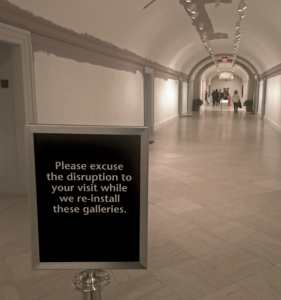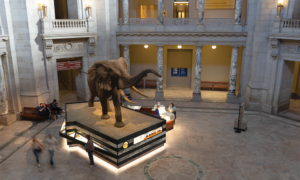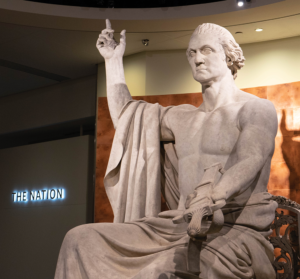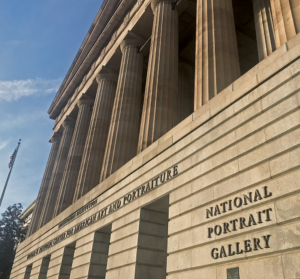
For most of January, one of the single most significant sources of knowledge in the world was sealed behind “sorry, we’re closed” signs. The largest museum and research complex in the world, the Smithsonian Institution, closed Jan. 2 as a result of the government shutdown that began Dec. 22 after exhausting reserve funds from the previous fiscal year. Its closure has had wide-reaching effects.
“The Smithsonian exists to really have a dialogue about sort of everything from the science to the humanities to who we are as a country in all of the various ways, so when something like the shutdown happens, it’s really too bad,” Kim Sajet, director of the National Portrait Gallery, said in an interview with The Hoya.
The 19 Smithsonian museums, including the National Portrait Gallery and the National Air and Space Museum, as well as the National Zoo, reopened Jan. 29 after President Donald Trump agreed to a temporary end to the shutdown. Yet the effects of this four-week closure will continue to ripple out over time as the museums reel from lost revenue and disrupted operations.
Forbidden Knowledge
The monthlong closure of this educational resource put life on hold for visitors and museum research staff alike as they were denied access to the Smithsonian’s array of museum artifacts and libraries, which draw students from around the world.
For graduate and doctoral students on deadlines, the shutdown could have severely impeded the academic process, as they provide resources inaccessible otherwise, according to Al Miner, director of the Georgetown University galleries.
“There are some things that just don’t exist in digital form, and a lot of people doing research fellowships and different programs in the Smithsonian and the National Gallery — part of the reason they applied to those fellowships was so they would have access to those things,” Miner said in an interview with The Hoya.
Internal researchers also experienced disruption caused by the shutdown. For example, one of the National Portrait Gallery’s curators was scheduled to speak at an academic symposium in January but was unable to attend as curatorial and educator travel was cancelled, according to Sajet.
The National Museum of Natural History experienced similar obstruction in its research, museum spokesperson Ryan Lavery wrote in an email to The Hoya.
“The museum was closed to our own research staff, as well as untold numbers of U.S. and international researchers who make use of our collections and collaborate with our scientists to further our understanding of the natural world, its biodiversity, and its people,” Lavery wrote.
Federal researchers were not allowed to conduct their research on-site or in the field, nor were they able to attend conferences, meetings or research trips, according to Lavery.

Even Georgetown felt the academic disruption. Its art and museum studies master’s program requires students to complete at least two internships in museums in the fall and summer, with the option to also intern in the spring, according to Miner.
“They need to do these internships to graduate. So what happens if a student had an internship lined up at one of the Smithsonian art museums and he was supposed to start the week that the shutdown started? So he never even started his internship,” Miner said.
The shutdown will have further effects for graduate students, such as potentially jeopardizing summer internship applications, according to Lisa Strong, director of the art and museum studies program.
“All the people who are coming back to work after missing a month are going to be really behind in their work, and they might not have time to evaluate applications or even to interview and hire students to do summer internships,” Strong said in an interview with The Hoya. “So it’s possible there will be fewer summer internships available to students, and that also impacts our program.”
In addition to internships, the program uses museums in other ways to supplement classroom learning; in the face of the shutdown, professors had to make other arrangements, Strong said.
“Many of us teach classes that make use of museums, where we have class meetings in museums,” Strong said. “I have one colleague who had planned his seminar to involve almost all museum visits, and he had to change the syllabus around to accommodate that.”
Exhibition Inhibition
Despite the reopening, the shutdown will have continued effects on the museums. The National Portrait Gallery approximated its own loss at between 150,000 and 180,000 visitors prevented from seeing its exhibitions because of the four-week shutdown, according to Sajet.
Smithsonian museums were forced to re-evaluate upcoming exhibitions in light of the time closed: “Striking Iron: The Art of African Blacksmiths,” an exhibit in the the National Museum of African Art, for example, was once planned for late February but has been postponed indefinitely. Furthermore, the Portrait Gallery pushed back its upcoming exhibition “Votes for Women: A Portrait of Persistence” from March 1 to March 29, nearly a full month, according to Sajet.
Even exhibitions scheduled much later this year are now in question as museums work to confirm loan contracts and other logistical concerns. “One Life: Marian Anderson,” an exhibit at the Portrait Gallery highlighting the iconic singer’s effect on the fight for civil rights, is now potentially in limbo, according to Sajet. Originally scheduled to open June 27, Sajet says the gallery is now waiting to see if that date is still possible.
“We have an exhibition marking the anniversary of Marian Anderson singing on the steps of the Lincoln Memorial in 1939, so we’re not quite sure what the opening time for that will be,” Sajet said.
This uncertainty arises from the schedule-specific nature of museums, according to Strong.
“It’s not as though a show that was supposed to open during the shutdown in the middle of January can just be pushed forward, because all the loans come in at a certain time, they’re scheduled to go back out, often a show goes to another venue after its Washington, D.C. one, so you can’t just push ahead the timeline,” Strong said.
Even as federally funded museums closed, effects transcended national borders and had consequences for museums on an international level, according to Miner.
“It hits on all these other museums in the country and around the world,” Miner said.
Delaying one exhibition may seem trivial, but that disruption can still have far-reaching effects for museums, according to Miner.

“It’s this crazy machine that’s always churning. You might be planning, I’d say as early as three years in advance to as late as seven to 10 years in advance on an exhibition,” Miner said. “It may not sound like a lot, but it’s gonna sort of snowball as you go through that process.”
The time wasted by the shutdown is a huge loss, both for visitors who would benefit from the exhibitions and for the museums that began planning them years in advance, according to Miner.
“A museum is investing a lot of money and a lot of time and a lot of love in the shows that they’re planning,” Miner said. “When you offer them to the public, you think you’re gonna get, say, 12 weeks or 16 weeks or however long your museum keeps this particular exhibition on view — you just dramatically decreased the value of what you have invested in staff time and money for what the public actually gets.”
Shutdown Misfortune
Visitors to the museums were the most visibly disrupted by the shutdown. Around 45,000 visitors per day were prevented from accessing the museums while they were closed, Smithsonian Secretary David Skorton wrote in a Jan. 22 op-ed in USA Today. Programs, tours and special events in every museum were cancelled or rescheduled.
Financial repercussions from the shutdown could also have long-term consequences for future exhibitions and programs, Miner said. The Smithsonian Institution lost $3.4 million in gross revenue over the course of the shutdown with the closures of the museum cafes and stores, according to Alison Mitchell, a spokesperson for the National Air and Space Museum in an email to The Hoya.
“The loss of income that they sustain from those months has a direct impact on the kind of exhibitions they might be able to do in the future, how many programs for kids from public schools they can do in the future — because that’s what they pay for themselves,” Miner said.
In addition to their own financial loss, museums must contend with a blow to the centralized support services shared between the museums. Those central services are pressured not only by loss of revenue but also by increased demand for them as all the museum staff return at once, according to Sajet.
“There’s gonna be a domino effect in seeing how quickly the entire Smithsonian can get back into its swing of things, because of course those centralized services are all going to be crunched [for time],” Sajet said.
Access Denied
The programs and tours cancelled or postponed as a result of the shutdown are another loss for the public. During the Portrait Gallery’s closure, it cancelled 26 public programs, not including daily docent tours, and turned away 37 school groups — just under 2,000 students, Sajet said.
These programs are often the kind the larger population does not see, according to Miner.
“There are programs for military veterans in almost every museum, programs for kids who are home-schooled; there are programs for kids with special needs; there are programs with people with visual impairments to experience art through touch,” Miner said.

These programs also span age groups, providing resources to everyone from toddlers to teenagers to adults, according to Concetta Duncan, head of communications at the National Portrait Gallery.
“That’s one of the things of being part of the Smithsonian, is that we really try to diversify our programs for different pockets of the public,” Duncan said in an interview with The Hoya. “So when you have something like this, with the shutdown, it really is affecting a really broad range of people.”
The shutdown’s closure of federally funded — and thus free-to-enter — museums also had an effect on who had access to the knowledge in Washington, D.C. cultural institutions, Miner said.
“It’s very different when through things like federal funding you can make anybody have the right to enter. It’s a special, rare, uniquely Washington thing,” Miner said. “If you take it away, it definitely will impact what kind of people have access to art and history.”



















